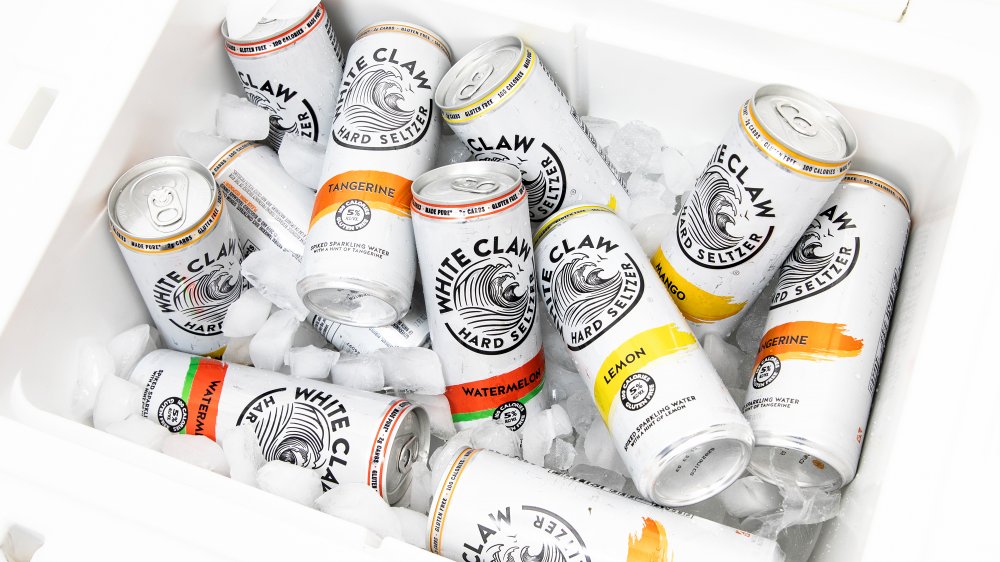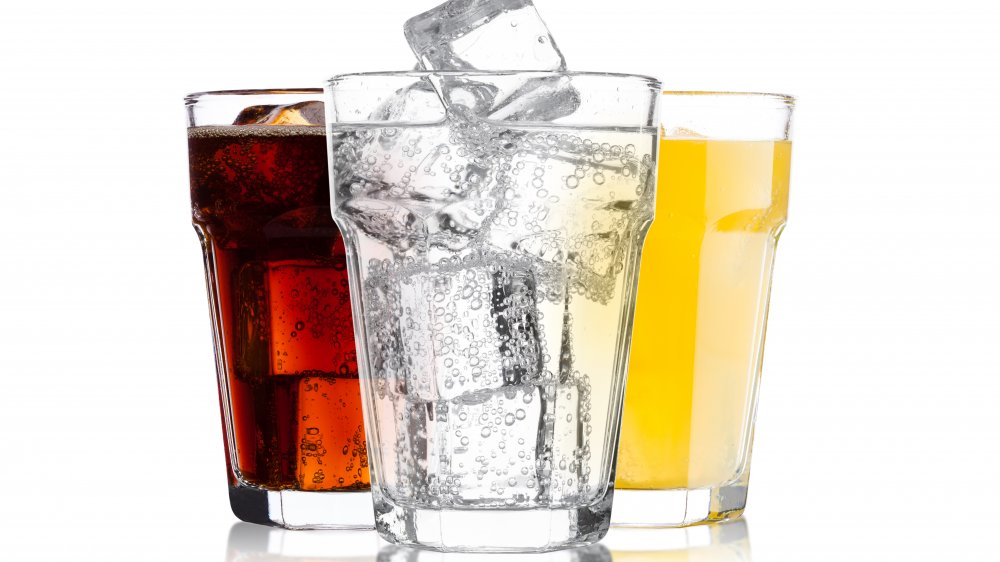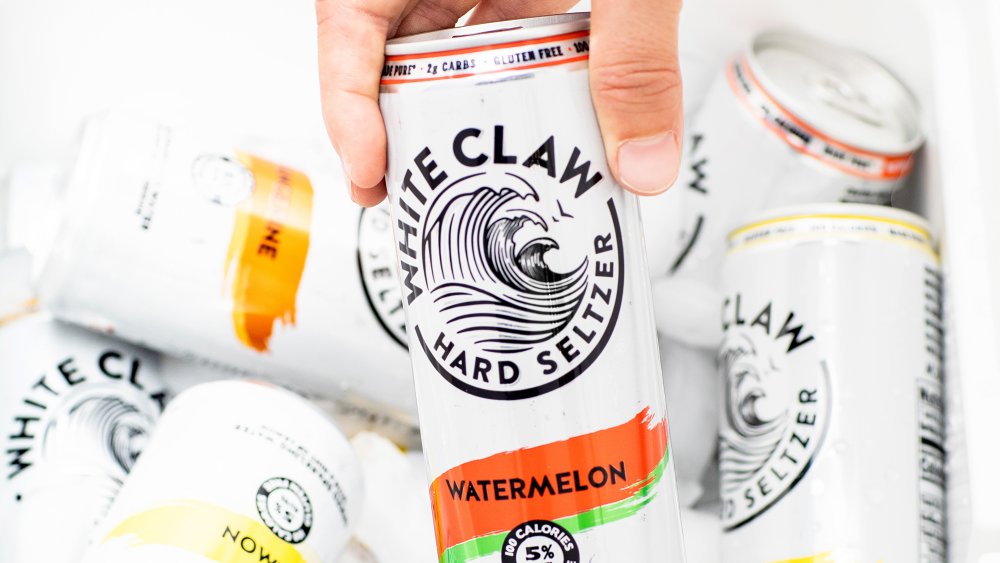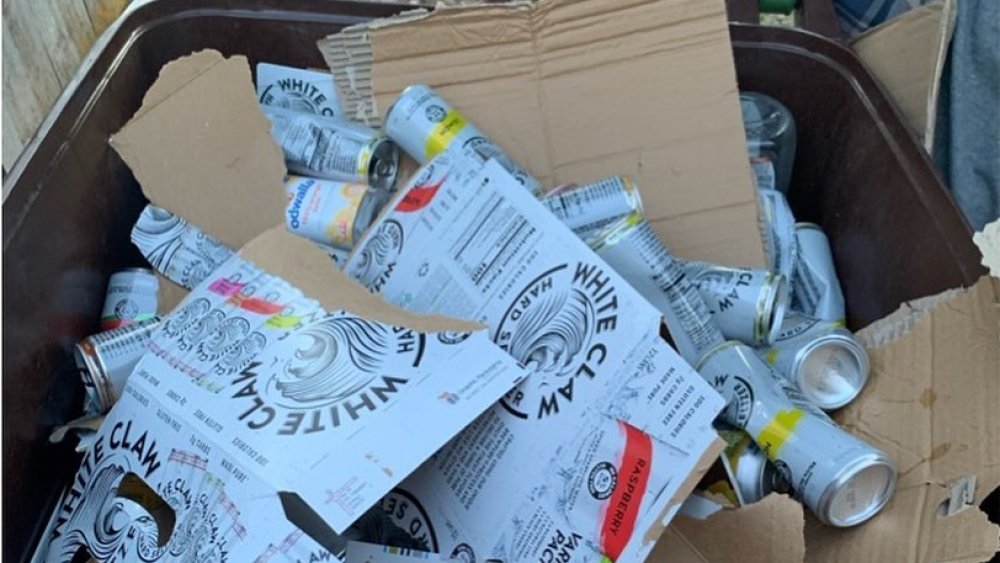Here's What Happens When You Drink White Claw Every Day
Move over, beer and wine. Alcohol consumers are making room in their fridge for a third option. Everyone these days seems to be drinking and talking about hard seltzers, especially White Claw. Sales of hard seltzers grew a whopping 238 percent in 2019 (via Brewbound), and White Claw owns 60 percent of that market (via CNN). White Claw arrived in 2016 but didn't rise to the status of summer's unofficial party drink until last year (via Salon). BuzzFeed says White Claw went viral, both online and at grocery stores, after YouTuber Trevor Wallace posted a video in June 2019 titled "Drinks White Claw once."
White Claw may be just a fad, or it might be a new category of alcoholic beverage, as market researchers believe. Either way, if you want to catch the White Claw wave, it would be good to know what happens if you drink the stuff every day. After all, if you're going to the party, you might as well keep the party going, right? Well, maybe — but maybe not.
You'll be healthier drinking White Claw instead of other alcoholic beverages
A lot of people bought White Claw last year simply because it was trending on social media. But market observers also think the beverage was a hit because it's perceived as healthier than beer (via Forbes). The seltzer's stats do compare favorably to beer's — 100 calories and two grams of carbohydrates per 12-ounce can, compared to 150 calories and 15 or more grams of carbs in a typical beer (via US News & World Report). White Claw is also both keto-friendly and gluten-free — two claims most beer can't boast.
On the other hand, White Claw (and most other alcoholic beverages) have no nutritional value worth mentioning. Those 100 calories per can are empty calories, which means a White Claw should be considered a guilty pleasure, like dessert (via Everyday Health). People think carbonated beverages cause cavities because of the carbonic acid that results from forcing carbon dioxide gas into the beverage to make it bubbly. However, this is not so, according to Healthline.
However, citric acid is added to a lot of carbonated beverages — including White Claw — as a flavor enhancer. Citric acid is strong enough to wear down tooth enamel, according to Healthline. The next time you go to the dentist worrying about your daily White Claw intake, console yourself with the knowledge that White Claw has a lot less sugar than many other alcohol options.
Your daily White Claw is unhealthy in the long run
Forget what you heard about French people being healthier because they drink so much red wine. A recent study in The Lancet with 600,000 subjects showed that anything more than one drink per day shortens your lifespan (via Vox). The U.S. government says it's okay for women to drink one alcoholic drink daily, and men can have two servings of alcohol a day (the latter is contrary to the Lancet study).
This should not be taken as a reason to drink, however. The guideline "does not recommend that individuals who do not drink alcohol start drinking for any reason," the government report says. Alcohol is associated with all sorts of adverse health outcomes, including liver problems, heart disease, high blood pressure, addiction, and mental health issues, according to the CDC. On top of all that, the World Health Organization gives alcoholic beverages its highest ranking for carcinogens.
Some scientists are taking all this bad news with a grain of salt — or maybe a shot of whiskey. Health studies can always be questioned because other factors, such as income and exercise levels, aren't always taken into account. Even one of the authors of the Lancet study said we need to chill out about its conclusions: "If you try to abide by every public health warning out there for every adverse effect, you'd have a miserable life. You wouldn't do anything."
However, this doesn't mean you should start downing White Claw on the regular — keep moderation in mind instead.
White Claw will take a bite out of your budget
A daily White Claw habit will cost you. Walmart's website shows it runs around $15 for a 12-pack, or over $1 per can (prices will vary depending on your location). If you were to drink Rolling Rock beer in your daily regimen, then the same retailer would sell you a 30-pack for close to $15, or 50 cents per can. The White Claw price must be part of the reason Trevor Wallace, in his YouTube video, quipped, "It's like a Four Loko that went to private school."
Regular White Claw drinkers consume, on average, 2.83 cans per sitting. At that rate, you'll be spending around $26 per week on White Claw, which might be less than some people spend at Starbucks (via Cliff & Pebble), but consider this: for single people age 19 to 50, a "moderate" food budget (somewhere between thrifty and spendy) would be $71 per week for women and $83 for men (via Choosing Voluntary Simplicity). Just like you need to count those empty White Claw calories in your diet, you should probably figure White Claws into your food budget. Given these numbers, you probably need to start calling White Claw "dinner."
Be prepared for the White Claw backlash
The 1990s had Zima. In the 2000s, it was Smirnoff Ice. Where are these clear, light, and refreshing alcoholic beverages today? Zima is long gone, and Smirnoff has so much faith in its Ice that it jumped on the White Claw wagon by introducing a hard seltzer in May 2020 (via Forbes). So who's to say White Claw won't suffer the same fate — insanely popular for a season, only to fall just as far, just as fast?
Despite industry projections that hard seltzer sales will triple again by 2023, Jeff Alworth of the Beervana blog says the fad won't last. Not only is that the way of the boom-and-bust alcohol market, Alworth said, but seltzers just don't taste good — or taste like much of anything. "... [T]hey're fundamentally uninteresting, and when the novelty wears thin, so does the trend," he wrote.
If White Claw and other hard seltzers are going to be a category and not a fad, then they're going to have to replace something else. Overall alcohol consumption in America isn't changing. A likely victim of seltzer's rise is light beer, which is already seeing a significant drop in sales (via Forbes).




